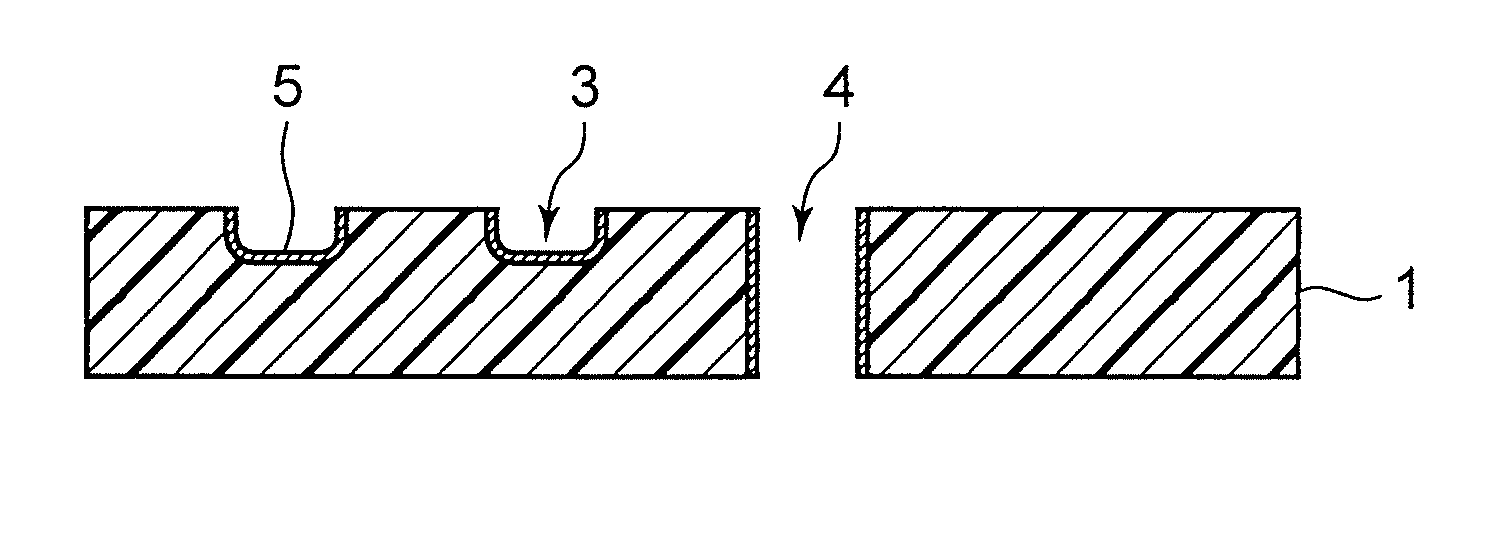Method of producing circuit board, and circuit board obtained using the manufacturing method
a manufacturing method and circuit board technology, applied in the direction of printed circuit assembling, metallic pattern materials, chemical vapor deposition coating, etc., can solve the problems of short circuiting or migration between the wirings that can easily occur, the production cost is disadvantageously high, and the metal from the removed portions is wasted
- Summary
- Abstract
- Description
- Claims
- Application Information
AI Technical Summary
Benefits of technology
Problems solved by technology
Method used
Image
Examples
first embodiment
[0029]The method of producing a circuit board according to the present embodiment includes a film-forming step of forming a resin film on a surface of an insulative substrate; a circuit pattern-forming step of forming a circuit pattern portion by forming a recessed portion having a depth equal to or greater than a thickness of the resin film, with an outer surface of the resin film serving as a reference; a catalyst-depositing step of depositing a plating catalyst or a precursor thereof on a surface of the circuit pattern portion and a surface of the resin film; a film-separating step of removing the resin film from the insulative substrate; and a plating step of forming an electroless plating film only in a region where the plating catalyst or the precursor thereof remains after the resin film is separated.
[0030]First, the method of producing a circuit board according to the first embodiment of the present invention will be described. FIGS. 1A to 1E are schematic cross-sectional vi...
second embodiment
[0125]In the first embodiment, a circuit board is explained that is obtained by forming an electric circuit on a flat insulative substrate, but the present invention is not limited to such a configuration. More specifically, a circuit board (steric circuit board) provided with an electric circuit with accurate wiring can be also obtained by using an insulative substrate of a three-dimensional shape such that has a stepwise steric surface as the aforementioned insulative substrate.
[0126]A method of producing a steric circuit board according to the second embodiment will be explained below.
[0127]FIGS. 4A to 4E are schematic cross-sectional views illustrating each step of the process of producing a steric circuit board according to the second embodiment.
[0128]First, a resin film 2 is formed on the surface of a steric insulative substrate 51 having a stepwise portion as shown in FIG. 4A. This step corresponds to a film-forming step.
[0129]Various resin molded bodies such that can be used...
example 1
[0138]A film of a styrene-butadiene copolymer (SBR) with a thickness of 2 μm was formed on the surface of an epoxy resin base material R1766 manufactured by Panasonic Electric Works Co., Ltd. with a thickness of 100 μm. The film was formed by coating a methyl ethyl ketone (MEK) suspension (manufactured by Japan Zeon Co., Ltd., acid equivalent 600, particle diameter 200 nm, content ratio of solids 15%) of the styrene-butadiene copolymer (SBR) on the surface of the epoxy resin base material and drying for 30 min at a temperature of 80° C.
[0139]The epoxy resin base material having the film formed thereon was then subjected to groove formation processing of forming grooves of substantially rectangular cross section with a thickness of 20 μm and a depth of 30 μm by laser processing. A MODEL 5330 equipped with a UV-YAG laser and manufactured by ESI was used for the laser processing.
[0140]The epoxy resin base material having the groove formed therein was dipped into a cleaner conditioner (...
PUM
 Login to View More
Login to View More Abstract
Description
Claims
Application Information
 Login to View More
Login to View More - R&D
- Intellectual Property
- Life Sciences
- Materials
- Tech Scout
- Unparalleled Data Quality
- Higher Quality Content
- 60% Fewer Hallucinations
Browse by: Latest US Patents, China's latest patents, Technical Efficacy Thesaurus, Application Domain, Technology Topic, Popular Technical Reports.
© 2025 PatSnap. All rights reserved.Legal|Privacy policy|Modern Slavery Act Transparency Statement|Sitemap|About US| Contact US: help@patsnap.com



